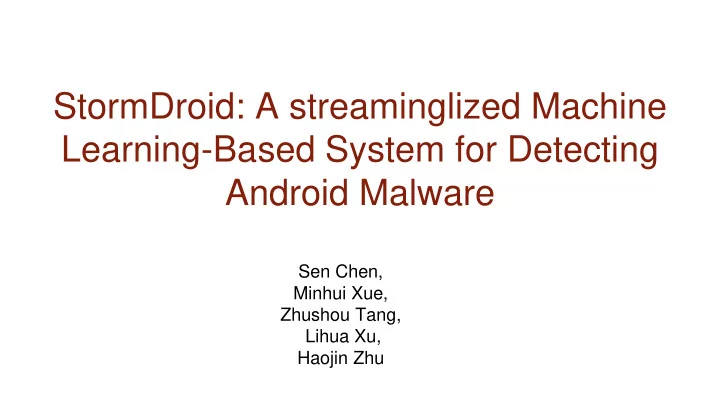

StormDroid: A streaminglized Machine Learning-Based System for Detecting Android Malware Sen Chen, Minhui Xue, Zhushou Tang, Lihua Xu, Haojin Zhu
Malware Detection in Android ● 1.6 million apps in Google Play Store in July 2015 ○ Many more in third-party websites ● Malware Rates - Attacked devices surged 75% from 2013-2014 ● Easy to publish apps in android.. 1 in 5 are malware ● Existing malware tools detect only widely known malwares ● Innovative ways in infecting devices ○ Third party developer stolen keys ○ Zero day exploits to get root access
Countermeasures ● Existing countermeasures ○ Signature-based - Once Android markets find a potential malicious app, they will record its signature of the corresponding app for a more in-depth detection later. ○ Behaviour-based - prior work is mostly in Static Analysis ● Behaviour-based - StormDroid ○ Static Analysis - identifies suspicious traces of data to detect known threats ○ Dynamic analysis - Observes actual execution but leads to excessive consumption of OS
Machine Learning for Malware Detection ● Machine Learning helps sift through large sets of applications for malware detection ● Shortcomings of existing techniques in Machine Learning: ○ Features are restricted to Permissions & Sensitive API calls ○ Lack of large-scale data sets for training ○ Validation measures don’t fare well in reality - 10-fold cross validation ○ Unreasonable amount of time taken while processing a large-scale dataset
Background - Android Manifest
Compiling APK
Security Approaches ● Market Protection ○ Signing ○ Review by playstore ● Platform Protection ○ Sandboxing - VM for each app ○ Permissions - either a benign or a malicious app may require the same permissions ■ New versions have dangerous permissions which aren’t granted during installation time
StormDroid Framework
StormDroid Three phases in execution: ● Preamble - reverse engineering to get resource files ● Feature extraction - extraction of features from combined set of contributed features and creation of binary input vector ● Classification - ML models for classification of an app as benign or malicious
Framework cntd.. Work flow of the detection process is in following topology: ● Submitted app is first disassembled to extract its features static profiling tools: apktool, dex2jar, java decompilation tool ○ ● Differential metrics of the app are calculated ● Run intersection analysis and output a binary input vector ● All the data associated with the app are in a single stream ● Concurrently processes multiple streams ○ enables a market to efficiently detect a large number of submissions.
Classification ● Training performed on 3000 apps ● Total app samples - 7970 apk files ○ 4350 benign apps ○ 3620 malicious apps - includes phishing, trojans, spyware, root exploits
Feature Extraction ● Features ○ Well received features ■ Permissions ■ Sensitive API Calls - obtain Smali files from the static decompiling Telephony ● ● SMS/MMS ● Network/Data ○ Newly-defined features ■ Sequence ■ Dynamic Behaviour
Feature extraction contd.. Permission settings & Sensitive API calls are indeed relevant to the benign or malware behaviors
Feature extraction - Sequences ● Subtraction-Differential metric: D1 (resp. D2 ) as the set of top values of d(s,m,b) (resp. d(s,b,m) ) that outnumber the threshold 200 ➔ D=D1 ∪ D2 ● Logarithm-differential metric: top 16 values that are greater than 0.4 (set L1) and the bottom 11 values of that are less than 0.05 (set L2) ➔ L=L1 ∪ L2
Feature Extraction - Sequences ● Subtraction-Logarithm metric ➔ S = D ∩ L ➔ if the APK contains at least one of the features either in set D1∩L1 or in set D2∩L2 , Add weights +(d(s,m,b)/1,516) or −(d(s,b,m)/1516) to sum, respectively; ◆ ➔ if the (sum value of the set S) > 0.4, the corresponding sequence is heuristically marked as ‘1’ otherwise, it is marked as ‘0’
Feature extraction - Dynamic Behaviour ● Apk file is run in DroidBox 6 ○ Incoming/outgoing network data ○ File read and write operations Started services and loaded classes through DexClassLoader ○ ○ Information leaks via the network, file and SMS ○ Circumvented permissions Cryptography operations performed using Android API ○ ○ Sent SMS and phone calls ○ two images showing the temporal order of the operations and a treemap to check similarity between analyzed packages. ● Static analysis of the saved log files to extract the top features of dynamic behaviors.
Feature extraction contd.. Several well-known features do not help distinguish between benign and malicious apps, which will increase system overhead. They choose 1,516 benign and malicious APKs to prune well-known features of benign and malicious apps in all categories.
Results
Evaluation Randomly 1000 malicious apps are chosen for comparison ❏ As per the authors, this helps understand coverage and avoid over-fitting
Scalability ● StormDroid outperforms single thread by approximately three times in each group
Thoughts ● Evolving malware requires evolving malware detectors ○ Recent malware samples should be collected constantly to evolve the model ○ Attacks against learning techniques ■ Malwares can incorporate benign features to affect detection scores ■ Frequent retraining on representative datasets can mitigate such attacks ● Decompilation to source code is more difficult than to smali files ○ Repackaging doesn’t affect StormDroid ○ But even standard code obfuscation techniques makes reverse engineering very difficult. It impairs the StormDroid Framework
Recommend
More recommend